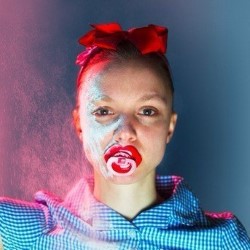Baby Face questions our paradoxical society: we condemn paedophiles, but we regularly witness teenage models of all genders, presented provocatively, in retail store marketing, fashion magazines and advertising. At what point is it no longer acceptable to find these young people attractive? This is the question that performer Katy Dye asks.
This is deliberately uncomfortable viewing. Through physical theatre, song, speech and audience participation, Dye deploys her physicality to stupendous effect. Following a boisterous opening, she transforms in front of our eyes from 26 year old woman to teenager to younger teenager to child, toddler and finally, a gurgling baby. Her physical observations and her vocalisations are disconcertingly spot on. Her Britney Spears routine is rivetingly appalling. Her use of costume to signal the gradual transformation, superb.
Audience participation is smartly orchestrated to invite just the right amount of simpering pleasure through to disgust when Dye makes us complicit in the oftentimes sexualisation of women and children. And she doesn’t shy away from the uncomfortable truth that women and girls can – with a big caveat, sometimes – be complicit, inviting partners, peers and society to cosset them in the way of the child, to cushion them from the hard things in life.
Set is minimal but a smoke machine doing over-time provides a suitably unsettling atmosphere for the start of the show, a high chair centre-stage glinting eerily when it catches the light. The technical support for this show is fabulous. Dye periodically uses a microphone to caterwaul over and under a thumping soundtrack. But much of her dialogue is delivered unamplified and in a compact space, the effect is claustrophobic. Zac Scott has done a tremendous job with a tightly engineered soundtrack that drives the show forward to its dark conclusion.
By the end of the performance, there’s no doubt that Dye is angry. Phenomenally topical, this is an issue too rarely raised in a climate where we’re happy to point the figure but not so happy to recognise our role in perpetuating the problem. The physicality of the show conveys the injustice in spadeloads. It would have been interesting to see more reflection and less aggression to give the show a bit more balance and depth. As a performer, Dye’s stillness is more unsettling than her frenetic energy. But this is a daring take on one of society’s few remaining taboos: Katy Dye deserves all the stars for audacity.
